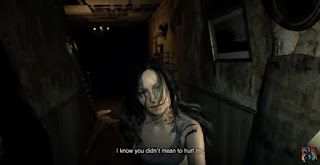A Quite Place is the kind of film that
feel like it was originally meant to be some kind of vanity/arthouse horror
project that was somehow warped into a more conventional horror film. It
features a rather creative high concept premise that requires the actors to act
almost exclusively through their body language and facial expressions. It has a
lead actor who also directed, co-wrote and co-produced the film and is the kind
of film that would otherwise be so overwhelmed by the ego of said actor that it
would be impossible to take seriously. Yet despite all of the warning signs, A Quite Place actually tuned out to be a
solid little horror film and is a decent way to spend an hour and a half.
The
film takes place in the United States roughly a year and a half after a race of
creatures began appearing, seemingly out of nowhere and began killing off the
world’s population. No one seems to know what they are or where they came from.
All that anyone seems to know is that are blind, have incredible hearing that
can pick up a noise from miles away, very fast, very dangerous and very tough
to kill. Our story focuses around a family of upstate New York farmers who are
trying to live their day to day lives while trying to make as little noise as
possible lest they attract the monsters. And that’s about it.
This
is one of those of films that is sold on a single original idea but is
otherwise rather formulaic. The plot isn’t elaborate and doesn’t really get any
more complicated beyond that. Whether or not it’s actually any good relies on
how well they execute said original premise and incorporate it into said
formulaic plot. But, in this case, the execution is, for the most part, spot
on. What makes it work is that there is a subtle air of tension is every single
scene. It doesn’t constantly shove it in your face with jump scares or moments
where the characters almost make a noise but just manage to avoid doing so. You
are, however, always aware that any misstep made by these characters could cost
them all their lives. It takes what would otherwise be tedious, mundane scenarios
and turns them in to life or death situations
This
all eventually comes to a head in the second half of the film when one of these
characters actually makes one of these missteps and kicks off the film’s
climax. From then on you can cut the tension in every shot with a knife as the
monsters creep around while the family desperately tries not to make a sound in
situations where all you want to do is scream. The crown jewel, however, has to
be at the film’s midpoint and adds several layers of tension to what was
already a tense, nail-biting film. I won’t spoil what it is but it’s the kind
of event that tremendously raises the stakes and has you praying that the
characters can keep quiet while knowing that it is all but impossible.
What ultimately
glues it all together, however is the family. You buy that this family is legitimate.
It’s clear that the father loves his kids but has some trouble expressing it to
his eldest daughter, possibly due to an early film tragedy. The daughter
clearly has issues with the dad regarding this tragedy and feels neglected as a
result. The son has a great turn as a kid who has responsibilities thrust upon
him that he clearly unready for but none the less has to take on. The only real
weak link in the cast is the mother. This is mainly because the film doesn’t
give her much to do beyond being the terrified housewife though she does sell
the hell out of it and does have some badass moments at the film’s end. But for
the most part the character relationships work and help keep the stakes high by
successfully making us care about them,
That’s
not to say, however, that the film doesn’t have problems. We never really get
any kind of explanation as to what the monsters are or where they come from
which is a tad bit frustrating. It has to be said that their designs are rather
generic and boring looking like a generic mutant from the Resident Evil games or something. It also has to be said that the
film has a bit of a structuring problem as it seems to lack a clearly defined
third act. You have the first half where everything is quiet and the characters
go about their daily lives and the second half where they’re hiding from the
monster and there doesn’t seem to be anything resembling a finale in the film.
If anything, it seems to end right before the third act was suppose to start
and ends up feeling like we were cheated out of the actual ending as a result.
But these things only slightly take away from the overall experience.
In
the end, A Quiet Place is by no means
perfect but is an otherwise decent way to spend an hour and a half. It’s
suspenseful, dramatic and a welcome breather from all the hundred million-dollar
projects that that we have and will be bombarded with over the spring/summer
season. I say give it a look.
Overall
8/10
So
until next time, please be sure to follow the site, Like my page over on
Facebook, follow me on Twitter, check out my other work over at The Nerd Hub
and Heroic Hollywood and please considering donating to my personal Pateron to
support this article and other projects like it. Until then, lets hope that the
summer season has some more good movies to bring.














